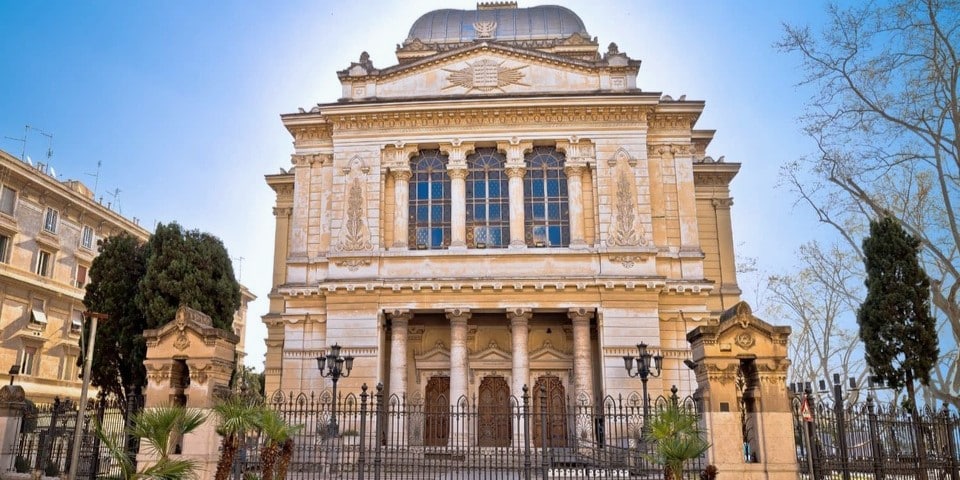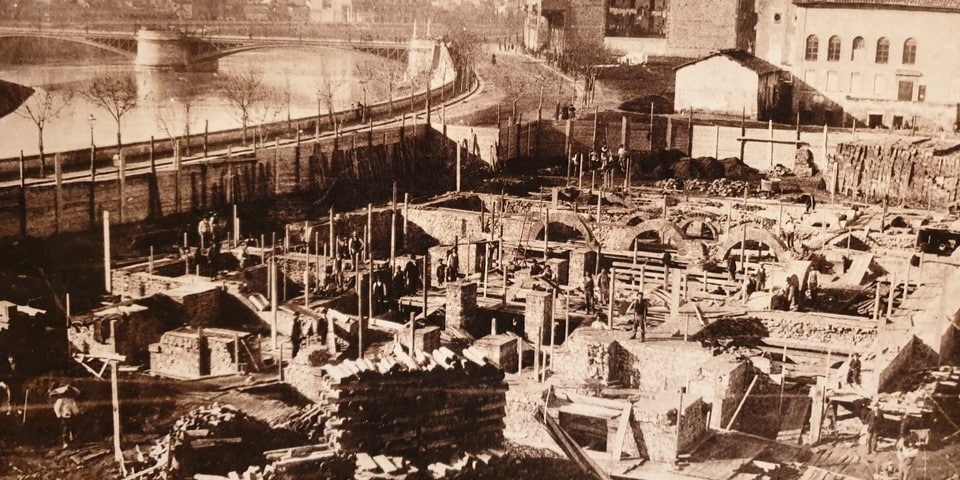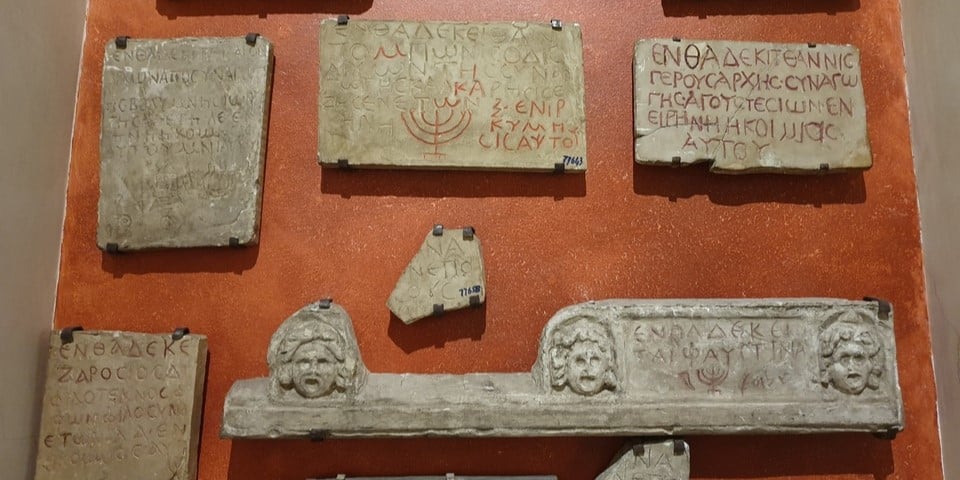

24847 views

| Tip | The Synagogue can only be accessed through the Jewish Museum and must be visited as part of a guided tour offered by the museum. |
|---|---|
| Opening Hours |
Sunday:
-
Monday:
-
Tuesday:
-
Wednesday:
-
Thursday:
-
Friday:
-
|
| Recommended tour | |
| Closest bus stops |
|
| Closest subway stations |
|
| Address | Lungotevere de' Cenci, Roma |
| Website | romaebraica.it |
The Great Synagogue (Italian: Tempio Maggiore di Roma) is a place for prayer and a symbol of the freedom of the Jewish community in Rome. Also, it serves as a cultural center for the community. The Jewish Museum of Rome inside shows the history of the Jewish community in the Eternal City.
Contents
ToggleOsvaldo Armanni and Vincenzo Costa designed the Great Synagogue. Between 1901 and 1904, construction took place. Importantly, they chose an eye-catching ArtDeco style to commemorate the newly discovered independence of Rome’s Jewish community.

The Italian king Victor Emmanuel II granted Rome’s Jews full citizenship during his reign. As a result, the community started preparing for a new place of worship after the historical destruction of the old Synagogue.
Judaism is a religion, the first to embrace monotheism, i.e. the belief in one G-d.

According to tradition, Judaism developed among the Semitic tribes with Abraham, in a region that we can place historically between Caldea and Canaan around the 16th century BCE. It was Moses in the 13th-12th century BCE who gave the Jews their self-awareness as a people, leading them into the Land of Israel, and transmitting the Divine Law: the Ten Commandments written on the Tablets of the Law, and the Torah”Pentateuch”, i.e. the first books of the Bible. The 613 mitzvoth (commandments) that Jews are obliged to observe are drawn from the Bible.
The diaspora started after the Roman conquest, and the Jews were dispersed throughout Spain and along the coasts of the Mediterranean (Sephardic Jews), in Central and Northern Europe (Ashkenazi Jews), and in Italy, where Jewish colonies already existed.
Along with the Orthodox tradition (the point of reference of Italian and Roman Jewry), even if not everyone in private observes every single commandment), modern Judaism comprises other movements. Especially in English-speaking countries, these movements aim to modernize some exterior aspects of Judaism (Conservative Judaism) or otherwise do not consider themselves strictly bound by tradition (Reform or Liberal Judaism).
Nowadays there are 15 million Jews worldwide, 35.000 Jews in Italy, and 13.500 Jews living in Rome.
The Jewish Museum of Rome contains splendid works donated by Jews living in the Ghetto (1555-1870) to their five synagogues or “cinque scole”. The synagogues were not only places for prayer, but also centers of congregation and study. They were the comfortable living rooms missing in the small, dark, damp houses of the Ghetto, and the Roman Jews showed their attachment to these common houses with sumptuous gifts.
First, Jews were traditionally money lenders; their banks held precious or antique objects in exchange for money they lent. When pledges were not redeemed, they were sold to recover their money. Therefore, one of the banks’ complementary businesses was the antique trade. These two activities continued hand in hand until 1682 when Jewish loan banks were abolished to foster Christian banks, known as Monti di Pieta. While the Jews were forbidden to work as bankers, trading in luxury items remained their other occupation.
As far back as the 16th century, Jews bought and sold furniture, textiles, and antiques and provided complete, ready-to-use interior furnishings for the palaces of the nobility, for people residing in the city temporarily, or during special events such as conclaves, periods of mourning, ceremonies, celebrations, performances, and holidays.
During the ghetto period, the Jews of Rome were not allowed to work as silversmiths, so they had to turn to non-Jewish artisans when they wanted to donate to their synagogue. All the silver objects produced in Rome and on display in the Jewish Museum of Rome are the work of Christian silversmiths.
The textiles are primarily antique fabrics purchased second-hand from the palaces of the nobility. The Jews then adapted them for synagogue use, applying embroidery and trimmings. Needlework was one of the specialties of the Ghetto of Rome, with one unique characteristic: in a world where it was a male profession, in the Ghetto, the embroiderers were women.
Shortly after Italy’s unification in 1870, when the Kingdom of Italy captured Rome, and the Papal States ceased to exist, the current Synagogue was built. Jews received citizenship, and the Roman Ghetto was destroyed. The complex structure housing five scolas—the Italian-Jewish name for synagogues—in a single building that had served as the ghetto synagogue was demolished, and the Jewish community started making plans for a brand-new, impressive structure.
Commemorative plates have been affixed to honor the local Jewish victims of Nazi Germany and an Abu Nidal Organization attack in 1982.
The individuals then chose this eye-catching style because they wanted the structure to be a visible celebration of their freedom and seen from many locations within the city. As a result, the building is immediately recognizable, even from a distance, thanks to the aluminum dome, the only square dome in the city. In addition, the Synagogue’s interior is richly ornamented with Art Nouveau design.
It would be best to dedicate at least an hour to the Museo Ebraico di Roma when visiting the Great Synagogue of Rome to examine the museum. The collection’s exquisite organization takes visitors on a tour of the history of the Jews in Italy, from their arrival in Ostia in the second century BC until the present.
The collection on display at the Jewish Museum is simply outstanding. Its walls’ decoration includes historical decrees, liturgical objects, incunabula, and marble sculptures that detail the intriguing social history of the Jews in Rome and their struggle to maintain their identity despite the papacy.
Author: Kate Zusmann
This website uses cookies. For more info read the cookies policy
Rome.us © 2025. Created with love by Roman experts and guides.